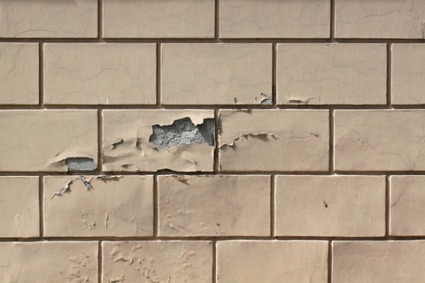Correctly preparing brick and masonry for painting depends on whether you’re painting the brick or masonry for the first time, or repainting it. Some prep is the same for both, so let’s look at the common exterior preparation steps you’ll go through for both new paint and repaint situations.
Surface Preparation for Brick and Masonry
New or old, the surface can be dirty. You need to use a good cleaner to remove any dirt or grease that may be on the brick or masonry. Then you must let the surface dry completely. Any moisture in the brick or masonry will cause the paint to peel. This must be given time to equalize. Hot dry summer days; it will take about 2 days for the brick to dry out completely.
Preparing New Brick and Masonry for Painting
While new brick has such an attractive appearance, and actually has the ability to protect the home very effectively, masonry such as concrete block or plaster, needs some type of seal to keep water out.
Masonry and brick alike need to cure for at least 30 days and in some situations up to six months. This allows the mortar, bricks and/or blocks to dry out completely. It will also be apparent by the end of this time, if there are any areas that have formed a powdery, unstable surface.
Ordinary primer and paint won’t adhere to brick or masonry that is crumbly. If the problem is just surface, there are stabilizing primers that can resolve the issue.
Once cement based plaster-stucco, has cured, the only preparation needed is to ensure the wall is free of dirt, mold, mildew and powdery areas. Primer may be waived in favor of using masonry specific coating or paint. Check with the manufacture or your supplier for preferred priming instructions for your coating.
Preparing Old Brick or Masonry for Repainting
Power washing is a good technique for cleaning old brick and masonry because it takes off flaking paint and reveals many structural issues that the paint may have been hiding.
In most cases, avoid the use of wire brushes as this can further damage an already damaged brick wall. Use a scraper to handle what power washing doesn’t deal with effectively.
If there are any areas that are damaged, they must be repaired before you repaint. Don’t expect a coat of paint to resolve issues with cracked bricks, loose pointing between bricks, crumbling mortar or loose cement. While a stabilizing primer can handle surface issues, paint and primer don’t strengthen a deteriorating structure. Problems that are covered up will continue to worsen.
Elasomeric paints can cover small cracks that are less than 1/16″ wide. Otherwise, use a chisel or router to open up any cracks, so they can be filled. Blow out any dust that forms, then fill with a quality, paintable patching compound. If the surface surrounding the patch is smooth, work or sand the patch smooth so it blends into the surrounding surface.
The most important consideration when preparing old brick or masonry for repainting is to make sure the wall is stable, free of chalky, crumbling brick or masonry and free of loose paint.


